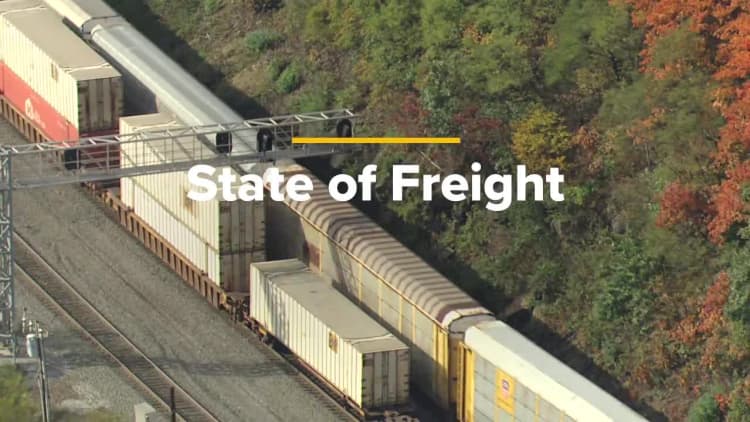
A cargo ship moves under the Bayonne Bridge as it heads into port on October 13, 2021 in Bayonne, New Jersey.
Spencer Platt | Getty Images
The Port of New York and New Jersey is moving ahead with new shipping container requirements for ocean carriers and fees for violations. The container late fee, which was originally to be implemented on Sept. 1, was delayed to allow for talks with ocean carriers about their concerns.
“The ocean carriers were not opposed to paying another fee, it was the process and mechanism we chose,” said Bethann Rooney, director for the Port of New York and New Jersey. “The one size fits all mentality would not work for every carrier.”
The port is replacing an across-the-board methodology that mandates 10% of a carrier’s imports as the number of empty containers a carrier would be required to export because it did not take into account how many containers permanently left the terminal by rail.
“Some carriers have heavier intermodal rail volume than others,” Rooney said. “For example, we have containers going to the West Coast and not coming back to New York. The formula did not consider that. With the new methodology, we are factoring in intermodal rail volume,” she said.

Instead of the 10% threshold, each carrier must show on a quarterly basis that their imports and exports are balanced. Intermodal rail balance will also be calculated. The carrier would be responsible for drawing down its empty box totals by 25% each subsequent quarter with the goal of depleting its total accumulation of empty containers by four business quarters. If a carrier is found in violation, a $100 fee per container out of balance will be assessed at a quarterly rate.
U.S. ports already have the highest container fees in the world.
Shippers have come to rely on East Coast ports more due to concerns about labor issues on the West Coast at ports including LA and Long Beach. The Port of New York recently became the nation’s busiest port, surpassing the traffic at the California ports. Amid the supply chain congestion issues of the pandemic era, new shipping routes from the East Coast ports to the West relying on rail have become more popular.
The talks with ocean carriers and stakeholders centered on how to increase port fluidity so empty containers can be moved out and open up new space for imports, which are growing. The port currently has 200 acres of property holding empty containers.
“We need that space for our increase in imports,” Rooney said.
She says that based on history the recent shift in trade to the East Coast’s largest port could stay.
“This is more than the ILWU strike fears,” Rooney said. “You have the rail issues, AB-5 trucking issue that has yet to play itself out in California. That is creating uncertainty. You also have new environmental requirements for trucks and fees to service the ports.”
She cited historical data showing that the port retained 65-70% of trade diverted during the last ILWU strike in 2014.
In response to the discussions, Rooney said ocean carriers are changing their port call rotation so they can bring back more empties. Instead of traveling north to south, the vessels are moving south to north so there is more space on the vessels to top off with more empties. Rooney also said the new, smaller ocean carriers that started during the pandemic are signing contracts with ocean carriers to bring back empties. Rooney says the mere threat of a tariff has sparked movement of empty containers.
“The container terminals have never seen such attention,” Rooney said. “Reports from the truckers are positive. They are already seeing a change and more fluidity to return empty containers. By this time next year, 75% of the accumulating empties will be gone and will remain balanced.”
CNBC Supply Chain Heat Map providers and Rooney say they continue to see more flow of shipments involving the Gulf ports. The increase in container volumes on the East Coast to Louisiana is a boost for CSX and Norfolk Southern. The increase in container volume in Houston is a boost for Union Pacific and BNSF, which is owned by Berkshire Hathaway. The rail congestion at the ports of Los Angeles and Long Beach have been a problem for most of the year. UP and BNSF service the West Coast ports and the delays are part of the reason behind the congestion at the port.
